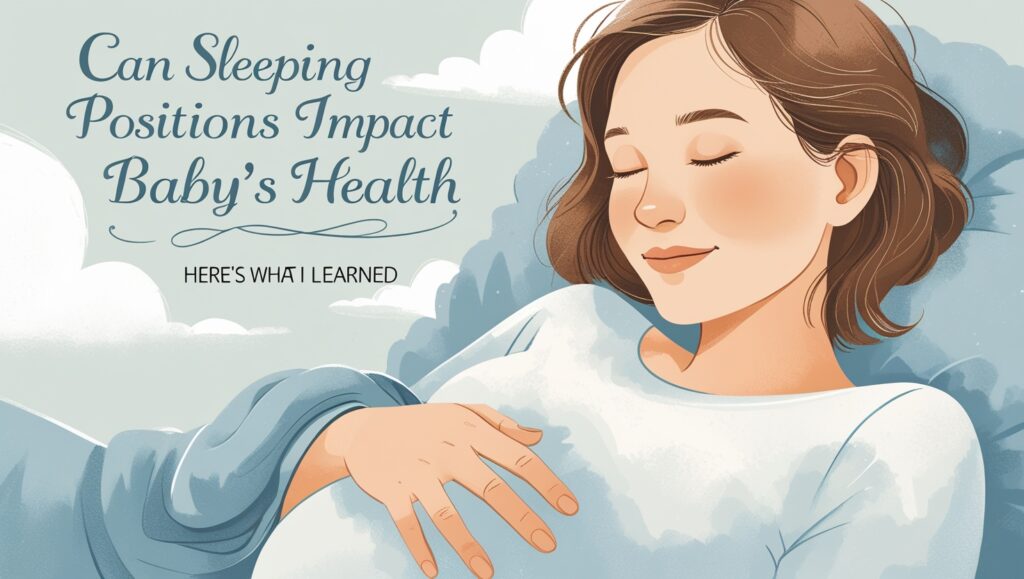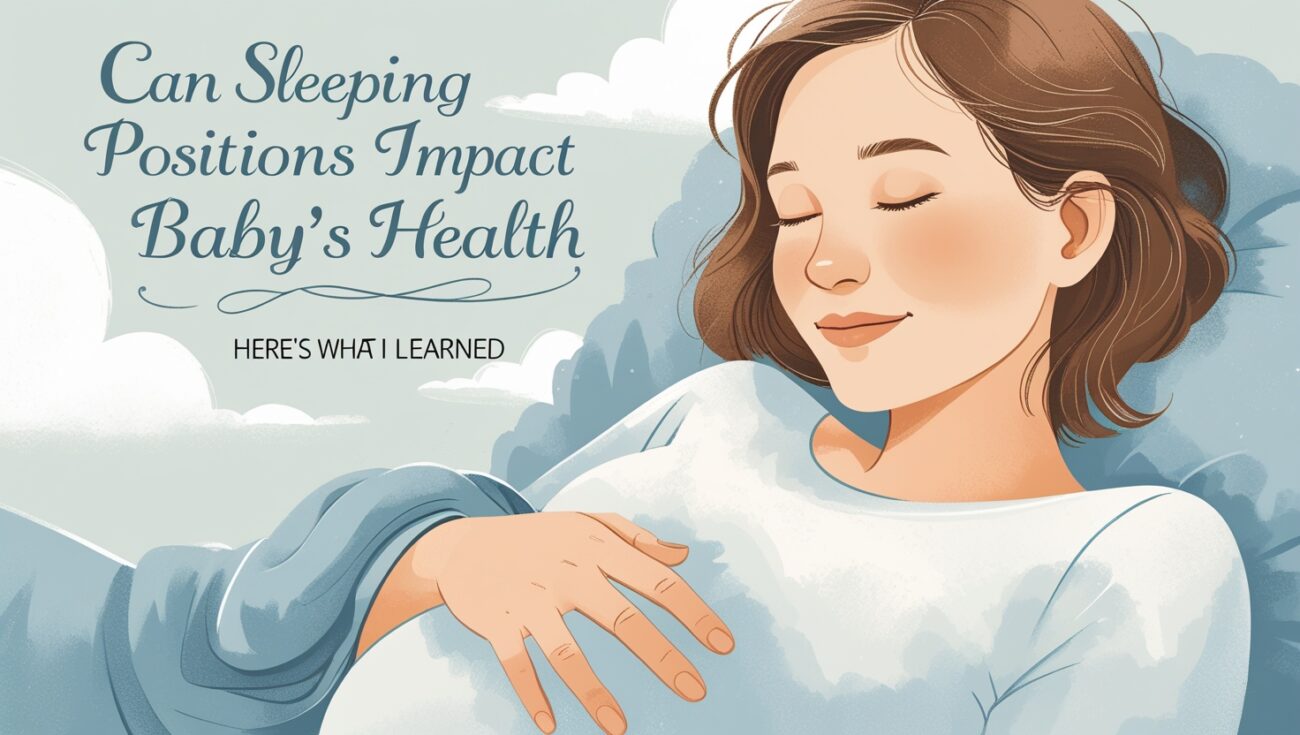Can Sleeping Positions Impact Baby’s Health? Here’s What I Learned
Yes — your sleeping position during pregnancy can impact your baby’s blood flow, oxygen levels, and growth. Here’s what I discovered, what the science says, and how the right pregnancy pillow made all the difference.

Table of Contents
Before pregnancy, I had no idea that the way I slept could affect my baby’s health. I thought if I was asleep, it meant I was doing something right. But in my second trimester, I started reading about how sleeping positions during pregnancy impact things like fetal development, oxygen flow, and even birth weight — and it changed everything.
Turns out, it’s not just about comfort. How you sleep can influence how well your baby grows, how well your placenta functions, and how your body circulates blood. That discovery led me down a rabbit hole — and eventually to the right pregnancy pillow that helped me sleep better and safer.
The Truth About Sleeping on Your Back During Pregnancy
One thing I learned quickly is that sleeping on your back after 20 weeks can actually compress a major vein called the inferior vena cava. This vein helps return blood from your lower body to your heart. When it gets compressed, it can reduce blood flow to the uterus, potentially lowering oxygen and nutrients to the baby.
I didn’t want to panic, but I definitely wanted to adjust my habits.
Why Left Side Sleeping Is Recommended
Every OB-GYN I spoke to — and every credible source I found — said the same thing: the left side is the best position during pregnancy. It improves placental circulation, kidney function, and helps reduce swelling in your legs and feet. It also takes pressure off your liver, allowing for better digestion and breathing.
How I Trained My Body to Sleep Safely
At first, I kept rolling onto my back without realizing it. That’s when I bought a U-shaped pregnancy pillow and it completely changed how I slept. It cradled my back and knees while keeping me on my left side without needing to stay alert all night.
Later I tried a C-shaped pillow, which also helped me maintain good posture and support my bump — without taking up too much space in the bed.
Symptoms I Experienced When I Slept Wrong
When I’d accidentally fall asleep on my back, I’d wake up dizzy, short of breath, and sometimes with numb legs. I didn’t connect it at first, but after talking to my midwife, I realized it was my circulation being restricted. That made it clear — sleeping right wasn’t optional.
Amazon Picks That Helped Me Stay in Position
U-Shaped Full Body Pillow
https://www.amazon.com/dp/B07QKZ4Z5S
C-Shaped Maternity Pillow
https://www.amazon.com/dp/B079K93TSR
Wedge Pillow for Back Support
https://www.amazon.com/dp/B07GH29KBP
Cooling Pregnancy Pillow for Better Circulation
https://www.amazon.com/dp/B07YNWZKF5
What the Research Says About Stillbirth Risk
This part really got my attention: several studies found a slightly increased risk of stillbirth when women sleep flat on their backs in the third trimester. While the risk is small, it’s real. The research points to reduced oxygen delivery to the baby, especially when back sleeping is prolonged.
How I Felt After Changing My Sleeping Position
Once I started sleeping on my left side with full-body support, everything changed. I woke up feeling more refreshed. I had less swelling. And my baby’s movements became more consistent — even stronger at night when I was fully relaxed and well-positioned.
Tips That Helped Me Stay in a Safe Sleep Position
- I used pillows behind my back to prevent rolling
- I kept one between my knees to align my hips
- I placed a wedge under my belly for support
- I started on my left side every night to train my body
- I stopped napping on the couch without pillow support
These small changes made a big difference.
Final Thoughts From My Experience
If you’re pregnant, please don’t ignore the role sleep positioning plays in both your health and your baby’s development. I didn’t know what I didn’t know — until I learned the hard way. The right pregnancy pillow doesn’t just make you more comfortable. It can support the circulation, alignment, and oxygen flow that your baby needs to thrive.
I read that when lying flat on your back, not only can blood flow decrease, but oxygen levels can dip, which may cause both mom and baby to become mildly hypoxic. It explained why I sometimes woke up feeling lightheaded after back sleeping — it wasn’t in my head. It was science.
I also found that sleeping on the right side is okay when you need to switch things up, but long-term, the left side is still ideal because it reduces pressure on vital organs like the liver. I trained myself to start on the left every night, and my pillow made it easier to stay there.
In the third trimester, my belly felt heavy and seemed to pull my body down when I lay on my side. That’s when I started tucking a small wedge pillow under my bump to reduce pressure and strain. It helped relieve that dragging sensation and made side sleeping more sustainable.
What surprised me most was that fetal movements were stronger and more frequent when I slept in the right position. I felt more kicks and rolls when I was properly aligned and supported. It gave me peace of mind that my baby was okay — and that my position mattered.
I also started tracking how I felt each morning depending on how I slept. When I stayed on my side with full-body support, I woke up with less swelling in my hands and feet. That confirmed the research about how sleep posture affects circulation and kidney function.
Some nights, I’d feel short of breath — and that’s when I learned that reclining just slightly with a back support pillow allowed my lungs to expand better. Pregnancy pushes everything up, and even a small incline can improve respiratory function during sleep.
One major shift happened when I switched to a cooling pregnancy pillow. Overheating can increase stress hormones, and keeping cool helped me sleep deeper and longer. Better sleep means better hormone regulation — and that supports both mom and baby.
I also learned that deep sleep helps regulate blood sugar, which is especially important for moms at risk of gestational diabetes. Since sleeping in the wrong position can disrupt deep sleep, I knew proper alignment wasn’t just about comfort — it was about protection.
It’s easy to think sleep is just passive rest, but in pregnancy, sleep is when your baby grows. Your body releases growth hormone during deep rest. Supporting good posture with pillows allows your body to stay in that restful state longer — which directly benefits fetal development.
I talked to my doctor about sleep position, and she said even if I rolled onto my back during the night, the key was starting on my side. The longer you remain in a side position, the better. That’s when I started using a pillow to prop behind me as a gentle reminder.
Even after birth, I continued using my pregnancy pillow while breastfeeding or co-sleeping safely. It gave me support and helped me maintain good posture while holding my newborn — continuing that commitment to safe alignment even after delivery.
The biggest thing I learned? Sleep positioning isn’t something to stress about — but it is something to be intentional with. Once I made small changes and used the right pregnancy pillows, I felt more in control, more supported, and more confident that I was doing what was best for both of us.

